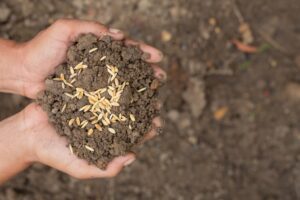Did you know? Behind better soil fertility in the USA and ensuring a good quality crop, an army of helpers works tirelessly within the soil. These unsung heroes are the soil microorganisms. These are tiny but mighty beings that have a crucial role to play in ensuring a better quality of yield. In the following section of the blog, we shall unravel the world of soil microorganisms, explore the benefits of soil microorganisms, their impact on soil fertility in the USA, and how technology is offering a helping hand.

Soil Microorganisms – The Tiny Powerhouses to Ensure Soil Fertility in the USA:
Soil microorganisms are tiny living creatures residing in the soil. There are different types, but the most common are bacteria, fungi, and actinomycetes. They work harmoniously, break down organic matter, release essential nutrients, and protect plants from harmful diseases.
How Do They Work?
The soil microorganisms are like the recyclers of nature. They decompose dead plant material and release nutrients like phosphorus, nitrogen, and potassium back into the soil. These nutrients are like food for the crops that help them grow big and strong.
Why are Soil Microorganisms Important?
Without the soil microorganisms, the soil would become completely lifeless and barren. They maintain the soil structure, prevent erosion, and even fend off harmful pathogens. In simple terms, they are the guardians of our fields. The soil is much more than a source of nutrients for plants. It is a complicated ecosystem of soil-dwelling organisms. The plants interact a lot with microbes and other living organisms. Therefore, they improve soil fertility in the USA, plant nutrition and health. This crucial activity takes place in the rhizosphere.
What is Rhizosphere?
The rhizosphere is a hub of activity within the soil. In this root zone around plants, plant roots feed the nearby soil microbes instead of plant nutrients. In this way, the rhizosphere acts as the bridge where the unavailable minerals are converted into plant nutrients. Here is how the rhizosphere works.
- Roots put the sugars down within the soil through photosynthesis.
- It creates a space of crowded, busy bacteria feeding in the rhizosphere.
- Roots exchange the microbial food instead of the nutrients that the plant needs.
Only 55% to 75% of the plant sugars support plant growth. The remaining go into the soil through the roots to feed the soil biology. The above version is a simplified form of events. The reality is there are intimate symbiotic associations between the mycorrhizal and rhizobial bacteria and plants.
The Benefits of Soil Microbes in the Rhizosphere:
The plant sugar from the roots feed soil microbes. The bacteria and other organisms residing in the rhizosphere make nutrients available to the plants and offer a protective layer against diseases and pests.
Why Do Plants Need Microbial Bridge?
The presence of soil minerals is crucial to enhancing plant growth and soil fertility in the USA. Plants need the minerals to grow, photosynthesize, flower, pollinate, and produce fruit or seeds. Since the soils are composed of 45% minerals, most of the minerals are not in the form that the plant can use. Soil microbes are the bridge between the soil minerals and plant roots.
Nitrogen:
Even though plants are surrounded by nitrogen in gaseous form in the atmosphere, the microbes can turn it into a usable form. Microbes also transform the soil’s organic nitrogen into mineral nitrogen that the plants can take up.
Sulfur:
Soil microbes change organic sulfur to change organic sulfur to plant-available sulfate. Other micronutrients benefit from the microbial bridge to make them plant-available. With nutrient movement and holding capacity, the microbes can change the form of nutrients to make plants available, change the acidity and alkalinity of the mineral, and hold nutrients in a way that makes things easier for a plant to consume when needed.
How to Build the Microbial Bridge to Improve Soil Fertility in the USA?
Improve Microbial Diversity—
Crop diversity causes abundant biology, which is crucial to building a strong microbe bridge. Having different plants means a diverse array of soil life because plants are specific to their microbes.
Growing a Mixed Plant Species—
By growing mixed plant species, you can populate a more heterogeneous group of microbes in the soil. Thus, no one population will be dominant, helping you develop a strong microbial bridge that offers a variety of minerals crucial for plant health.
Taking Care of Soil Biology –
Switching the focus from chemical inputs to caring about soil biology allows a stronger and more effective microbial bridge. Instead of relying on soluble fertilizers for plants, the microbes can effectively deliver the correct nutrients to the plants in the right form and quantities.
For the most in-depth soil mapping analysis and soil fertility testing, contact SoilOptix® today! Visit https://soiloptix.com/ for details.
